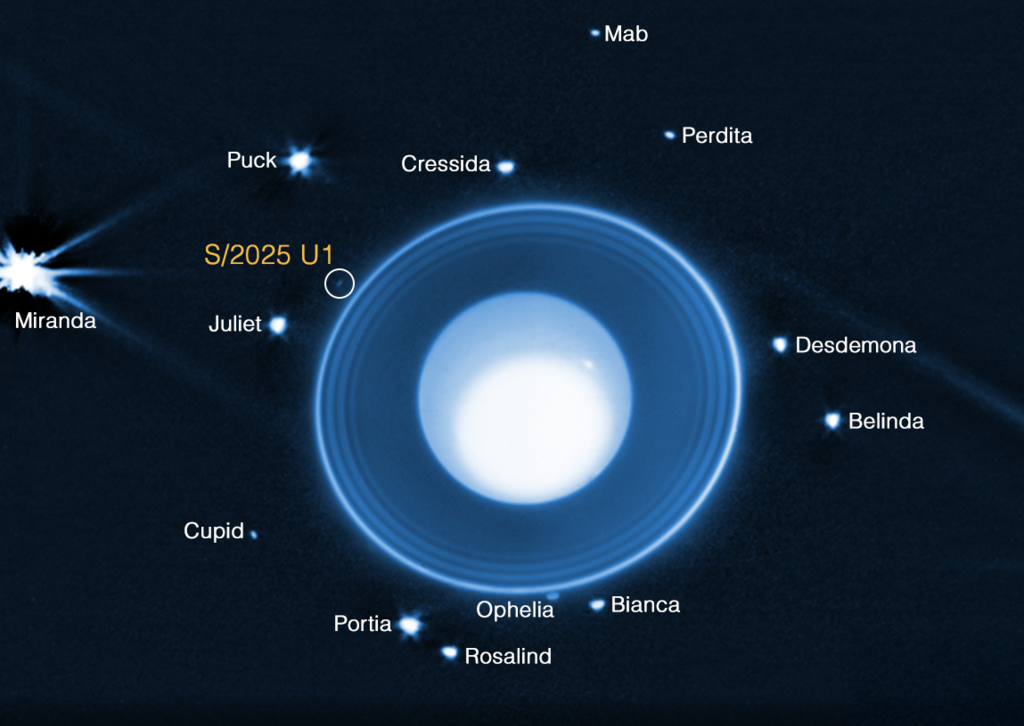New Moon Discovered Orbiting Uranus
Using the James Webb Space Telescope, astronomers have identified a previously unknown moon orbiting Uranus. With an estimated diameter of just ten kilometers, this small celestial body increases the known count of Uranian moons to 29.
Researchers in the United States, utilizing the James Webb Space Telescope, have discovered an additional, previously unknown moon orbiting the planet Uranus. With this finding, the total number of Uranian moons now stands at 29.
Provisionally designated S/2025 U1, the new moon is a rocky body measuring approximately ten kilometers in diameter. It follows a nearly circular orbit around Uranus, roughly 56,000 kilometers from Uranus’ center, positioned between the orbits of the moons Ophelia and Bianca. This makes it the 14th member of Uranus’ inner moon group, a collection of satellites that orbit much closer to the planet than the larger moons Miranda, Ariel, Umbriel, Titania, and Oberon.
The newly discovered moon orbits very close to the outer edge of Uranus’ rings, and its tiny size raises the possibility that it may, in fact, be part of the ring system itself.
“No other planet has as many small inner moons as Uranus, and their complex inter-relationships with the rings hint at a chaotic history that blurs the boundary between a ring system and a system of moons,” said Matthew Tiscareno, co-author of the study and a researcher at the SETI Institute in Mountain View, California. “Moreover, the new moon is smaller and much fainter than the smallest of the previously known inner moons, making it likely that even more complexity remains to be discovered.”

A rocky object just ten kilometers wide: the newly discovered moon of Uranus, seen near the planet’s rings in this infrared image from the James Webb Space Telescope | Source: NASA, ESA, CSA, STScI, M. El Moutamid (SwRI), M. Hedman (University of Idaho)
The moon was discovered in observations with the James Webb Space Telescope in February of this year. Because it is relatively small and faint, it was identified only through a series of observations that involved long exposures—between 10 and 40 minutes—using an infrared camera.
“It’s a small moon but a significant discovery,” said Maryame El Moutamid, lead scientist at the SwRI Solar System Science and Exploration Division in Boulder, Colorado, “Which is something that even NASA’s Voyager 2 spacecraft didn’t see during its flyby nearly 40 years ago,” she added, referring to the American probe that imaged Uranus up close in 1986.
The discovery of the new moon has not yet been formally published in a peer-reviewed scientific journal. Once it is, a name can be proposed—most likely in line with the established convention: all of Uranus’ moons are named after characters from the works of British playwright William Shakespeare and poet Alexander Pope. The proposed name must then be approved by a committee of the International Astronomical Union (IAU), which is responsible for assigning names to celestial bodies.
Uranus now ranks third in the Solar System by number of known moons, following Saturn, which currently has 274, and Jupiter, with 95. Neptune has 16, the dwarf planet Pluto has five, Mars has two tiny moons, and Earth has one large moon. TThe innermost planets, Mercury and Venus, have no known moons.
A short clip exhibiting images of the new orbiting moon around Uranus:



